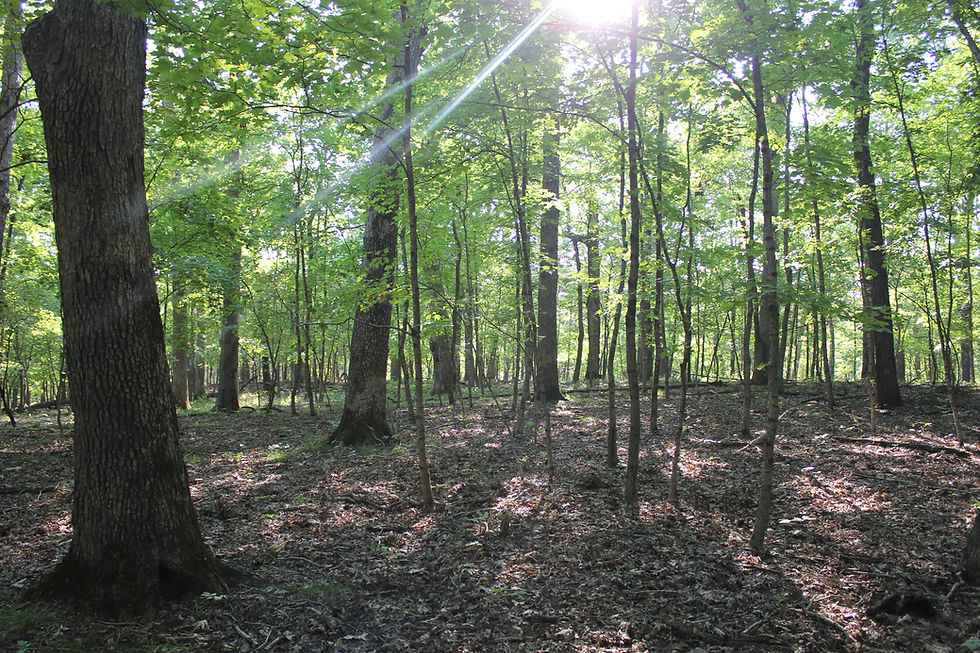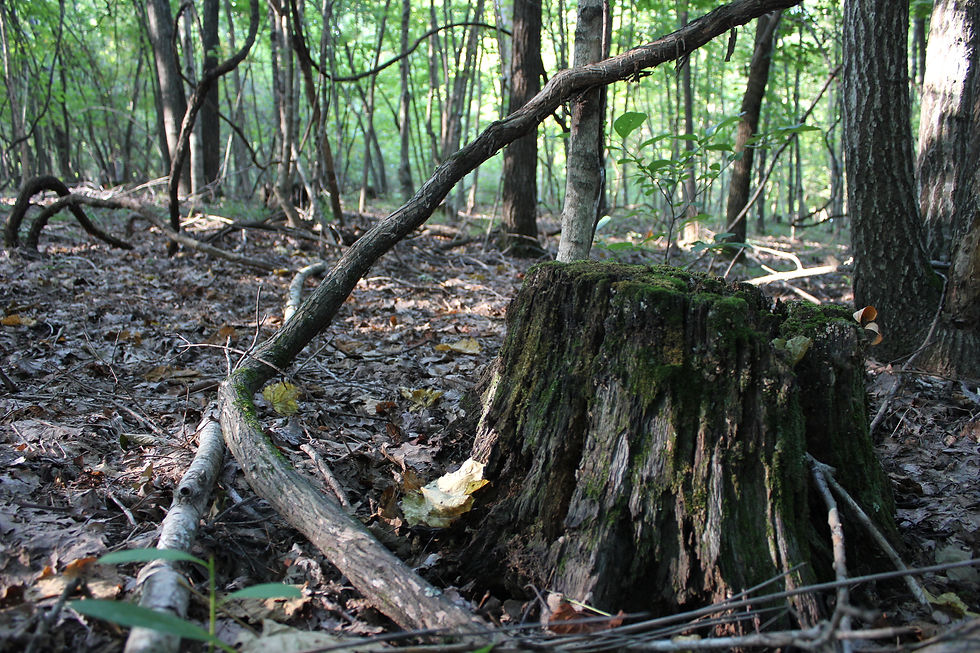New Paper Brief: clearcutting effects on forest development
- Ben Knapp
- Sep 17, 2019
- 6 min read
Updated: Sep 18, 2019
"Can clearcutting reset successional trajectories in upland oak-hickory forests? A case study from mid-Missouri" - Journal of Forestry 2019: Benjamin Knapp, Samantha Anderson, Patrick Curtin, Casey Ghilardi, and Bob Rives
This work was completed as a side project for the lab, initiated in 2016 due to interest in working together on something local, with opportunity to get to know each other better through field work and a common research question. We decided to work at the Baskett Center, the CAFNR research farm located within 20 miles from the MU campus, building off of an old study that was put in back in the 1980s. As a lab, we generated a research question, some straight-forward hypotheses, and a sampling design. We collected data in summer 2016, worked together on the analyses, and compiled a brief communication for publication in Journal of Forestry.
For background on this work, there are a few things to know. First, oak forests are considered to be important in the eastern US, for reasons that include cultural significance, aesthetics, habitat for wildlife species (acorns are favored by deer and turkey), compatibility with woodland management, and economic value in a variety of timber products (flooring, wine/whiskey barrels, railroad ties, etc.). Second, although oak species are currently very common as overstory trees in the central and eastern states, they struggle to replace themselves through natural regeneration. As a result, oak forests are transitioning to dominance by other species through time. A lot of research has gone into this to determine why and how management can be used to improve the regeneration of oaks.
From this past research, we have learned several things. Oaks have a regeneration strategy in which seedlings grow slowly in height but are able to persist in stressful environments, such as on poor-quality sites, with repeated fire, or with deer browse. In general, oak seedlings do best with an intermediate level of light reaching the forest floor; with high light levels, fast-growing tree species will do better than the oaks and at low light levels more shade-tolerant tree species will do better than the oaks. The oak seedlings and saplings need some level of canopy disturbance to provide enough light and growing space for them to continue height growth and eventually replace the canopy trees. Often, the best approach to manage for oak regeneration is to slightly increase light availability to encourage development of oak 'advance reproduction', or seedlings/saplings that are present beneath the overstory before a disturbance occurs. This can be done by lightly thinning the forest, using prescribed fire to kill small trees in the forest, or killing the small trees by cutting or herbicide. Then, with a larger canopy disturbance, the oak seedlings/saplings that are already present have a head start to grow up into the canopy.
In the absence of active management, the conditions needed for successful oak regeneration are not occurring very commonly. Instead, shade tolerant tree species, such as sugar maple, dogwood, ironwood, and musclewood, establish and grow into saplings within the forest midstory. This sapling layer can become dense and further shade the forest floor, creating additional challenges to oak regeneration. At the Baskett Center, we have used long-term forest monitoring plots to document forest dynamics since the 1960s in a recent paper published in the journal Forests. These plots clearly show a 'pulse' of sugar maple regeneration that has slowly moved from the forest floor to its current position in the midstory over the decades. These plots also show a lack of oak species as seedlings in the forest understory or saplings in the forest midstory, suggesting potential problems for replacing oak trees in the canopy in the future. (In addition, we have had episodes of canopy tree mortality due to drought and other factors, so anticipating the need for tree regeneration is important).

There are several silvicultural methods used to remove canopy trees and create favorable conditions for the regeneration strategies of desirable tree species. Clearcutting is a forest regeneration method that removes all canopy trees at the same time, with the objective of regenerating the forest in a high-light environment. Although perceptions of clearcutting are often negative, many of those perceptions are influenced by images of exploitative logging that is applied with no concern for regeneration, ecosystem health, or future conditions. As a silvicultural method, clearcutting is different than that, because it is applied to reach a specific objective related to regenerating the forest in a sustainable way.
Clearcutting is well-suited to regenerating tree species that are adapted to regenerating from seeds that either blow into the clearcut opening or are stored in the soil. In many cases, these species are also adapted for fast growth to utilize the high-light environment of the clearcut area. These fast growing species can be a problem for oak regeneration by quickly displacing the slow growing oaks and overtaking the site. There have been several studies that document that poor oak regeneration following clearcutting in Indiana, Illinois, West Virginia, and Kentucky. In general, oak regeneration success is more difficult in these states than in Missouri, due to the higher quality sites in the more eastern states and the absence of certain highly competitive tree species (such as tulip-poplar) in Missouri. In fact, in the Missouri Ozarks, where oak forests dominate and forestry is a major driver of the economy, oak regeneration occurs relatively easily with clearcutting methods (as well as with many other silvicultural methods).
So in this study, we wanted to evaluate the outcomes of clearcutting on forest development in mid-Missouri. There were about 10 clearcuts installed across the property in the 1980s. We selected six to use for the study, each of which occurred adjacent to oak-dominated forest that was similar in characteristics of tree species and size. Two clearcuts were located on ridges, two located on west-facing, exposed slopes, and two located on east-facing, protected slopes. The exposed slopes would be the harshest sites and the protected sites would be the best quality sites. We visited the clearcuts in summer of 2016 and sampled them to determine the tree species present, the size of each of those trees, and the species likely to develop into canopy trees in the future. One thing to note is that when forests regenerate after a clearcut or other disturbance, there are many, many small trees that establish. As these trees grow bigger, most of them die due to competition, and only a few become the canopy trees in the future. Although these forests were around 35 years old, many of the smaller trees will likely die in the future, with the trees dominating the crown space and receiving the most light expected to be canopy trees.
Our results showed that the site (exposed, ridge, or protected) really affected the outcomes nearly 35 years after clearcutting. As mentioned, oak species typically are better adapted to poor quality sites and are outcompeted on better sites. We found that oaks dominated on the exposed sites (pictured above on the left). Although sugar maple were present on the exposed sites as small trees, the oaks were the largest trees and would likely become the future canopy. The ridge and the protected sites showed different results, however (pictured above on the right). Sugar maple was an important component of both, but we also found that other species (black cherry, sassafras, ash, elms) were common as dominant trees on these sites.


It was a bit surprising to see the poor oak development on the ridge sites, which are expected to be relatively low quality sites. On these sites, the ridge areas had a loess cap, which changes the soil properties and may have affected the outcome by providing more mesic conditions due to greater water holding capacity. In addition, we noticed a lot of stumps still present on the ridge clearcuts but not in the clearcuts on other sites. This was a bit of a curious observation. It is known that oaks can resprout from cut stumps, and this is another strategy for regeneration success of oaks following larger disturbance events. Although we do not have data to show it, we suspect that more of the oak stumps sprouting following clearcutting on the exposed sites than on the ridge sites, although we do not know why sprouting would have been less on the ridges.
Overall, this study demonstrates that clearcutting can be a method used to regenerate a healthy oak forest in mid-Missouri, although site factors played an important role in the outcomes. Clearcutting on north-facing, high quality sites and on ridge sites with a loess cap did not result in oak regeneration success. Based on long-term monitoring plots at the research center, we also know that conducting no forest management is currently leading to the development of sugar maple in the forest midstory, with no oak seedlings and saplings in place for the future. This work provides an example of how silvicultural action can be used to reach certain management objectives (in this case, regenerating oak forests with clearcutting on exposed slopes). However, it also shows that silvicultural prescriptions must take into account characteristics of the species of concern, such as understanding its regeneration strategy of the species involved, as well as site-specific conditions. Studies such as this one can be used to inform the forest management practices used to address our management objectives sustainably.








Comments